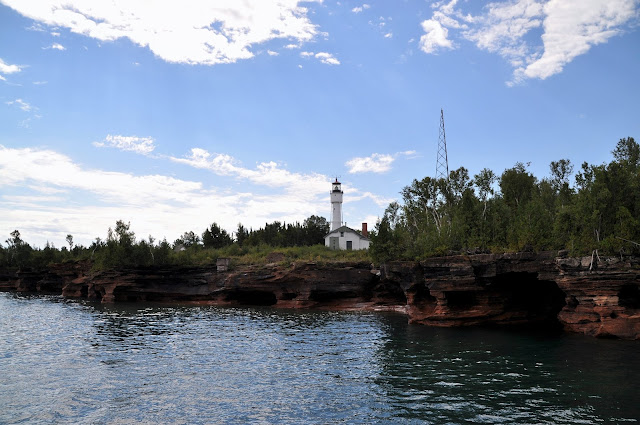
Sunday, September 13, 2015
DEVILS ISLAND LIGHTHOUSE-DEVILS ISLAND, WISCONSIN
When Devils Island Lighthouse was finally activated in 1901, it became the eighth and final lighthouse to be built in the Apostle Islands. On March 2, 1889, Congress appropriated $15,000 for a lighthouse on Devils Island, the most northern in the Apostle Island archipelago. When finished, the lighthouse would serve as a coastal light, splitting the gap between Sand Island and Outer Island. Deciding that the island would need a fog signal as well, the Lighthouse Board asked for and received an additional $5,500 for this purpose in 1890. In 1891, realizing an additional $22,000 would be needed to complete the station, the Lighthouse Board erected a four-story, pyramidal, wooden tower on the northern end of Devils Island to display a temporary, fixed red light of the fourth order. The light went into service on September 30, 1891, along with a ten-inch steam whistle housed in a one-story frame structure covered with heavy sheathing and corrugated iron outside and smooth iron inside. In addition to the fog signal and temporary tower, ten acres of land were cleared so the light could be seen from all points of approach. A brick oil house and the first of two, stunning, redbrick, Queen Anne style keeper’s dwellings were also erected in 1891, along with a landing and the station’s boathouse, situated at the southern end of the island. Built of half-inch-thick steel plates, the cylindrical tower stands eighty feet tall and was originally braced at its base by eight latticed buttresses that stood thirteen feet high. A similar tower was also erected in 1898 at the entrance to the Sturgeon Bay Ship Canal in Wisconsin, and it was soon found that the design had a major flaw: the tower would shake violently in high winds. In 1914, four of the buttresses were moved out from the tower and connected to vertical columns, linked with cross braces, that ran up the tower and connected to the watchroom. Also in 1914, the illuminant was changed to incandescent oil-vapor that increased the intensity of the red and white flashes. A radiobeacon was established on Devils Island on October 30, 1925. A powerful air diaphone fog signal replaced the steam whistle in April 1927, and in 1928 the light was electrified. By the time the Apostle Islands National Lakeshore was formed in 1970, all of the lighthouses in the archipelago had been automated and de-staffed save Devils Island Lighthouse. Following the automation of LaPointe Lighthouse in 1964, the Coast Guard crew at Devils Island was responsible for all of the lights in the Apostle Islands. This continued until 1978, when Devils Island Lighthouse was automated and the station that was the last to be built became the last to be de-staffed. Despite protests from local citizens and the Park Service, the Coast Guard removed the third-order Fresnel lens from Devils Island Lighthouse in 1989 after replacing it with a modern beacon mounted on the gallery railing. The lighthouse on Devils Island was the only one in the Apostle Islands still using a Fresnel lens. Local residents sued the Coast Guard for removing the lens from the tower, which had been placed on the National Register of Historic Places in 1977, without proper notification. Just three years later, the Park Service decided it would be fitting to return the lens to its original lantern room. After a Park Service conservator had spent three weeks restoring it, the lens was crated up and flown to Devils Island on a National Guard helicopter. On September 1, 1992, a tractor provided the power to hoist the 600-pound pieces up to the lantern room, where Robert Bolen, of Crescent City, California, reassembled them. Though inactive, the lens is at least back home where it had served mariners for over seventy-five years.
Subscribe to:
Post Comments (Atom)









No comments:
Post a Comment